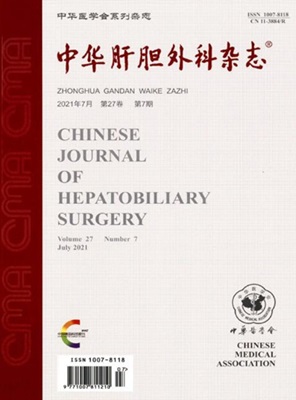The ultrasonic navigation technique in percutaneous transhepatic one-step biliary fistulation with rigid cholangioscopic lithotripsy for complicated hepatolithiasis
Q4 Medicine
引用次数: 0
Abstract
Objective To study the efficacy and safety of percutaneous transhepatic one-step biliary fistulation (PTOBF) with rigid cholangioscopic lithotripsy for treatment of complicated hepatolithiasis under the ultrasonic navigation technique. Methods In this retrospective study, PTOBF lithotripsy surgery was performed in 94 patients with hepatolithiasis under general anesthesia with tracheal intubation, and with percutaneous transhepatic puncture of targeted bile duct under ultrasonic navigation in The First Affiliated Hospital of Guangzhou Medical University. Biliary expanders were used along a guidewire to expand the sinus gradually until 14Fr to establish a fistulous channel. Lithotripsy was then performed through the channel by rigid cholangioscopy. The operation-related data were collected and analyzed, including puncture and fistula establishment success ratio, complication rate, intraoperative blood loss, residual and recurrence hepatolithiasis rates. Results 94 patients (total 122 patient-times) underwent PTOBF lithotripsy. There was no perioperative mortality. The overall puncture success rate was 100%, and the fistula/puncture rate was 97.5% (119/122). In 118 patients success was achieved in 2 time (96.7%). The complication rate was 9.6% (9/94). The average intraoperation blood loss were (24.9±21.3)ml. The residual calculus rate after therapy was 13.8%(13/94). All patients were followed-up for a period that ranged between 18 and 30 months. The recurrence rate was 14.9%(14/94). Conclusions Ultrasonic navigation technique plays an important role in bile duct puncture, sinus expansion and rigid cholangioscopic lithotripsy for treatment of complicated hepatolithiasis. PTOBF lithotripsy is a safe and effective procedure, which provides a new way in mini-invasive treatment for hepatolithiasis. It is worth generalizing. Key words: Ultrasound; Navigation; Percutaneous transhepatic puncture; Hepatolithiasis; Rigid cholangioscope超声导航技术在经皮经肝一步胆道造瘘合并硬胆道镜碎石治疗复杂肝内结石中的应用
目的探讨超声导航下经皮经肝一步胆道造瘘联合硬胆道镜碎石术治疗复杂性肝内胆管结石的疗效和安全性。方法回顾性研究在广州医科大学第一附属医院行PTOBF碎石术,对94例肝内胆管结石患者在全麻下气管插管,超声导航下经皮经肝穿刺靶向胆管。胆道扩张器沿导丝逐渐扩张窦,直至14Fr建立瘘道。然后在硬胆管镜下通过通道进行碎石。收集并分析手术相关数据,包括穿刺及造瘘成功率、并发症发生率、术中出血量、肝内结石残留及复发率。结果94例(122次)行PTOBF碎石术。无围手术期死亡。整体穿刺成功率为100%,瘘/穿刺率为97.5%(119/122)。118例患者2次成功(96.7%)。并发症发生率为9.6%(9/94)。平均术中出血量为(24.9±21.3)ml。治疗后残余结石率为13.8%(13/94)。所有患者的随访时间在18到30个月之间。复发率为14.9%(14/94)。结论超声导航技术在胆管穿刺、窦扩张及硬胆管镜碎石术治疗复杂性肝内胆管结石中具有重要作用。PTOBF碎石是一种安全有效的方法,为肝内胆管结石的微创治疗提供了新的途径。它值得推广。关键词:超声;导航;经皮肝穿刺;Hepatolithiasis;刚性cholangioscope
本文章由计算机程序翻译,如有差异,请以英文原文为准。
求助全文
约1分钟内获得全文
求助全文
来源期刊

中华肝胆外科杂志
Medicine-Gastroenterology
CiteScore
0.20
自引率
0.00%
发文量
7101
期刊介绍:
Chinese Journal of Hepatobiliary Surgery is an academic journal organized by the Chinese Medical Association and supervised by the China Association for Science and Technology, founded in 1995. The journal has the following columns: review, hot spotlight, academic thinking, thesis, experimental research, short thesis, case report, synthesis, etc. The journal has been recognized by Beida Journal (Chinese Journal of Humanities and Social Sciences).
Chinese Journal of Hepatobiliary Surgery has been included in famous databases such as Peking University Journal (Chinese Journal of Humanities and Social Sciences), CSCD Source Journals of China Science Citation Database (with Extended Version) and so on, and it is one of the national key academic journals under the supervision of China Association for Science and Technology.
 求助内容:
求助内容: 应助结果提醒方式:
应助结果提醒方式:


